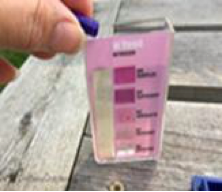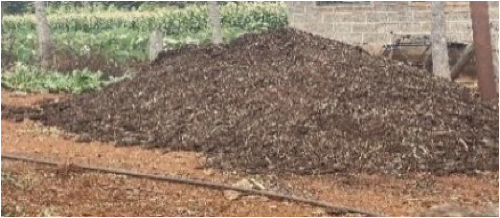Soil Fertility Management TIMPs
- Soil fertility is the ability of soil to grow crops and give maximum crop harvest.
- A fertile soil produces healthy food, which has necessary nutrients needed for human health.
- Practices that contribute to good soil fertility include use of fertilizers, use of manures, crop rotation, use of crops like legumes, use of improved seeds, and good agricultural knowledge.
Description: A set of soil fertility management practices that include:
- Use of fertilizers and organic inputs e.g., manures;
- Planting well adapted, diseases and pest resistant crops;
- Good agronomic practice – timely planting, correct crop densities, timely weeding;
- Crop rotation and intercropping with legumes or plants that help in increasing soil fertility.

Source KALRO
How to Apply Fertilizers
- Fertilizer banding – apply fertilizer directly in crop root-zone area.
- Micro dosing - apply small quantities of fertilizer with the seed at planting time and a few weeks after emergence.

What to Know When Applying Fertilizers
- Right source – get the right fertilizer for your crop and soil.
- Right fertilizer rate – use the right fertilizer amount depending on what the crop needs and size of land.
- Right time for fertilizer application – apply fertilizer when the crop needs it; basal fertilizer – apply at planting or just after planting; top dressing;
- Don’t apply fertilizer, or manure on wet soils - to minimize compaction, runoff and loss of nutrients.
- Right placement of fertilizer – apply the fertilizer where the crop can easily get the nutrients from the fertilizer.
What you Need Before Applying ISFM
- Affordable and quality manure, fertilizers.
- Clean planting materials e.g., seeds.
- Know your farm size.
- Have production resources like labor and money.
Benefits of ISFM
- Increased crop production leading to food security and incomes.
- Increased soil fertility.
- Stabilizes production.
- Reduces cost of production.
Description
- This is handling of livestock manure from collection, through treatment and storage up to application to crops (and aquaculture) depending on the location.
- This is important because manure can provide important soil nutrients and improve the soil health.
Housing and Manure Collection
- Housing will determine the characteristics of manure i.e., dry manure, solid manure, farm-yard manure, slurry and liquid manure.
- Animal housing should allow the collection of all dung and urine and prevent losses.
- Solid manure must be stored on a waterproof floor and with a cover against rain.
- Urine should be collected because it is a valuable nitrogen and potassium fertilizer.
- Flooring allows the farmer to collect both dung and urine.
- Roofing prevents run-off and nutrient losses due to rain.
- Urine can be captured using bedding materials.


Manure storage
Storage of manure is important because it: -
- Preserves crop nutrients until the time of application.
- Prevents runoff of nutrients to the soil and water.
- Prevents escape of nutrients into the soil and water.
- Prevents nutrients from volatilization/escaping to the air.
How to Store Manure
- Stackable manures: Heap the manure and compress the heap. Cover to protect the manure against the wind, water and sunlight.
- Liquid manures and slurry: Liquid manure is often the result of flushing the livestock house with water. Slurry needs a large storage capacity e.g., lagoons, outdoor silo or pit.
- Don’t keep mature compost for too long, it will lose some nutrients.
- You can produce a regular supply of compost by digging three pits (or piling three heaps) side by side. Every 2 to 3 weeks, turn the compost from one pit into the next one, and start a new compost pile with fresh vegetation in the empty pit.
How to Treat Manure
Composting
- Turns on-farm organic waste materials into a valuable soil amendment and fertilizer resource. Composting is suitable on all farms.
- Compost is a rich source of organic matter which sustains soil quality, is a source of crop nutrients, it improves the soils water holding capacity, and improves soils resistance to erosion.
- It is labor intensive and demands regular attention – collection of composting materials, setting up the heap, regular watering and repeated turning of the heap.
How to Tell a Mature Compost
- Compost materials become finer over time until a fine, loamy material is produced;
- The different materials are no longer recognizable;
- The material has a slight ‘earthy’ and harmless smell;
- Temperature drops and the compost is cool;
- Compost is dry.
How to Compost
The two most common are:
- Heap or pile method, suitable for large-scale processing and for small-scale operations in areas with higher rainfall.
- Pit method, suitable for small-scale processing in areas with low rainfall and a long dry season and for composting of liquid manures.
How to Apply Manure
Always refill the amounts of nutrients that are harvested with crops. The farmer should:
- Know the quality of manure through testing.
- Not apply manures before carrying out a soils test, to know how much is needed.
- Only apply manures at the time the crops need the nutrients.
- Apply the right amount that the crop requires. Avoid over fertilization.
- Should not apply slurry/liquid manure to fruits and vegetables grown for fresh consumption.
Basic Costs
- Labor for collecting the manure, building a compost heap, storing, maintaining it, transporting and applying it in the field.
- Flooring and or roofing of the livestock houses.
- Storage facilities.
Benefits
The benefits of using manure include:
- Reduces nutrient losses hence low environmental pollution;
- Produces biogas energy.
- Applying manure to soil increases soil health.
- Increased organic matter content increases the soils water-holding capacity;
- Better water-holding capacity improves resilience to climate change;
- Applying manure to soil improves crop nutrient supply;
- Improved crop nutrient supply enhances crop growth and yield, which contributes to food security;
- Enhanced crop production, increases farm income;
3. Rapid Soil Testing Services
- Soils should be tested to be sure of the type of fertilizer to use.
- This is a dry method for soil testing using the interaction of electromagnetic radiation with matter to characterize biochemical composition of a soil and/or plant tissue.
- Soil testing services are offered at some KALRO Centres and other institutions



4.Low-Cost Composting technology

- Biological decomposition of organic waste such as food or plant material by bacteria, fungi, worms and other organisms.
- One of the most effective processes for recycling organic wastes intended for use in agriculture
- Esilaba, A.O.et al. (2021). KCEP-CRAL CSA Extension Manual. Kenya Agricultural and Livestock Research Organization, Nairobi, Kenya.
- E. Teenstra, F. De Buisonjé, A. Ndambi, D. Pelster, 2015. Manure Management in the (Sub-)Tropics; Training Manual for Extension Workers. Wageningen, Wageningen UR (University & Research Centre) Livestock Research, Livestock Research Report 919.
- Esilaba, A.O. et al. (2021). KCEP-CRAL Integrated Soil Fertility and Water Management Extension Manual. Kenya Agricultural and Livestock Research Organization, Nairobi, Kenya.
- Fairhurst, T. (ed.) (2012) Handbook for Integrated Soil Fertility Management. Africa Soil Health Consortium, Nairobi.
Contacts
Kenya Agricultural and Livestock Research Organization
P.O. Box 57811-00200, Nairobi, Kenya
Call: 0111010100